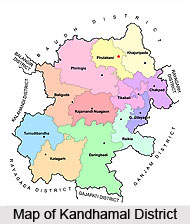 Ancient history of Kandhamal District may be traced back to 3rd century BC. Present Kandhamal District is made up with some segments of three erstwhile principalities of Boudh, Ghumusar and Khemundi, reigned by the Bhanjas and Ganga dynasty. Their reign came to an end with the arrival of British in this region in the 19th century. G. Udayagiri constituted the northern fringe of Ghumusara kingdom of the Bhanjas. They occupied this state and continued to rule till 1835. Ganjam came under the British rulers in the year 1765. The Bhanjas could not put up with their interference and they revolted against the British rulers. The Kandhas and the Paikas forming the Ghumusar army waged relentless wars under the able leadership of Dohara Bissoyi from 1815 to 1835.
Ancient history of Kandhamal District may be traced back to 3rd century BC. Present Kandhamal District is made up with some segments of three erstwhile principalities of Boudh, Ghumusar and Khemundi, reigned by the Bhanjas and Ganga dynasty. Their reign came to an end with the arrival of British in this region in the 19th century. G. Udayagiri constituted the northern fringe of Ghumusara kingdom of the Bhanjas. They occupied this state and continued to rule till 1835. Ganjam came under the British rulers in the year 1765. The Bhanjas could not put up with their interference and they revolted against the British rulers. The Kandhas and the Paikas forming the Ghumusar army waged relentless wars under the able leadership of Dohara Bissoyi from 1815 to 1835.
History of Kandhamal District also states that the British rulers occupied Ghumusar on November 3, 1835 by deposing Dhananjay Bhanja for his habitual uprising. After the death of Dhananjaya Bhanja, Balliguda region was under the Ganges of Kandhamal, most probably from the 10th Century and this dynasty ruled over these hilly tracts till the 19th century. British captured this area in phases from 1830 to 1880 by conquering some hill chiefs, who were the prot,g,s of the Gangas.
Ghumusar and Balliguda regions were under the uninterrupted reign of the Bhanjas and Gangas, respectively, for about a millennium. But the Kandhamal area, which was part of Boudh, witnessed a chequered history during the same period. The present Kandhamal sub-division was an integral part of Boudh from time immemorial till 1855. The earliest history of Kandhamal District is gleaned from a number of copper-plate inscriptions issued by the kings of the Bhanja dynasty, which reigned over Boudh and Kandhamal in the 8th and 9th Centuries. Their kingdom was known as Khinjali Mandala. From the 10th Century to the advent of British in this region, Boudh, including Kandhamal, has been governed in succession by the following royal dynasties: Somvanshi, the Chindak Nagas or Telugu Chodas, the Kalchuris and the Bhanjas. The history of Boudh and Kandhamal for 500 years prior to the arrival of British is however, still vague.
British rulers launched a vigorous campaign in these hilly tracts with the objectives of annexing the areas to their empire and suppressing the repulsive practice of human sacrifice, then prevalent among the Kandhas. British encountered stiff resistance from the tribal communities for a prolonged period of 20 years from 1835 to 1855. As Boudh Raja utterly failed to curb the terrible ritual of the tribal communities, British reduced a large area, where the Kandhas were predominant, from Boudh on February 15, 1855 and named this newly annexed territory as Kandhamal.
After British invasion of Uttar Ghumasar and Uttar Khemundi (Balliguda area) these territories were placed under the administration of the collector of Ganjam District. These areas remained under the control and administration of the British until India attained independence. Kandhamal remained a Tehsil from 1855 to 1891 and it was administered by a Tehsildar under the direct control and supervision of the superintendent of Cuttack. In 1891, it was upgraded to sub-division and tagged with Angul district. When the new province of Orissa was formed in the year 1936, and Ganjam was merged with Orissa, from the Madras presidency, Kandhamal became a sub-division of Ganjam. After the amalgamation of Ganjam with Orissa in January 1948, Boudh and Kandhamal constituted the new district of Boudh-Kandhamal, with its headquarters at Phulbani.
Balliguda sub-division was added to Boudh-Kandhamal district on 1st of January, 1949. With the secession of Boudh from Phulbani district as a separate district only Balliguda and Kandhamal sub-divisions remained with Phulbani district, which was later rechristened as Kandhamal District in June, 1994.



















